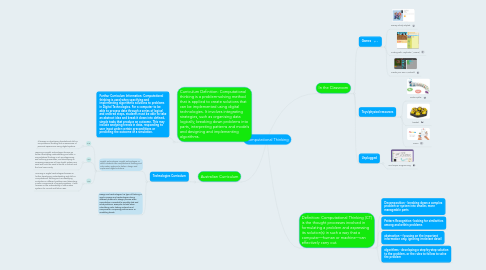
1. Australian Curriculum
1.1. Technologies Curriculum
1.1.1. Digital Technologies: Digital Technologies, in which students use computational thinking and information systems to define, design and implement digital solutions.
1.1.1.1. F-2
1.1.1.1.1. It focuses on developing foundational skills in computational thinking and an awareness of personal experiences using digital systems.
1.1.1.2. 3-4
1.1.1.2.1. Learning in Digital Technologies focuses on further developing understanding and skills in computational thinking, such as categorising and outlining procedures; and developing an increasing awareness of how digital systems are used and could be used at home, in school and the local community.
1.1.1.3. 5-6
1.1.1.3.1. Learning in Digital Technologies focuses on further developing understanding and skills in computational thinking such as identifying similarities in different problems and describing smaller components of complex systems. It also focuses on the sustainability of information systems for current and future uses.
1.1.2. Design and Technologies: his type of thinking is used in Design and Technologies during different phases of a design process when computation is needed to quantify data and solve problems. Examples include when calculating costs, testing materials and components, comparing performance, or modelling trends.
2. Curriculum Definition: Computational thinking is a problem-solving method that is applied to create solutions that can be implemented using digital technologies. It involves integrating strategies, such as organising data logically, breaking down problems into parts, interpreting patterns and models and designing and implementing algorithms.
2.1. Furthur Curriculum Information: Computational thinking is used when specifying and implementing algorithmic solutions to problems in Digital Technologies. For a computer to be able to process data through a series of logical and ordered steps, students must be able to take an abstract idea and break it down into defined, simple tasks that produce an outcome. This may include analysing trends in data, responding to user input under certain preconditions or predicting the outcome of a simulation.
3. Definition: Computational Thinking (CT) is the thought processes involved in formulating a problem and expressing its solution(s) in such a way that a computer—human or machine—can effectively carry out.
3.1. Decomposition - breaking down a complex problem or system into smaller, more manageable parts
3.2. Pattern Recognition -looking for similarities among and within problems
3.3. abstraction – focusing on the important information only, ignoring irrelevant detail
3.4. algorithms - developing a step-by-step solution to the problem, or the rules to follow to solve the problem
4. In the Classroom
4.1. Games
4.1.1. Disney Infinity Playlab
4.1.2. Coding with Wayfinder ( Moana)
4.1.3. Create your won Mindcraft
4.2. Toys/physical resources
4.2.1. Code-a-pillar
4.2.2. beebot
4.2.3. Osmo
4.3. Unplugged
4.3.1. Grid Paper Programming
